
Croatia’s oldest and largest national park, Plitvice Lakes has long been renowned for its pristine natural beauty… but there is more to discover here than meets the eye. Beyond the terraced lakes and tumbling cascades lie a region home to fascinating history, rich traditions, and warm, friendly people. Here, Tasteful Croatian Journeys shares our guide for guests visiting Plitvice Lakes National Park for the first time. From practical information to choosing the right trail, this guide covers everything you need to know.

Plitvice Lakes National Park consists of 16 crystalline lakes, emerald-blue in color and connected by a series of more than 90 cascades and waterfalls.
The park has been divided into two sections, the Upper Lakes and the Lower Lakes, based on their geological features. The twelve Upper Lakes were formed on impermeable dolomite rock. The names of the lakes are Prošćansko Jezero, Ciginovac, Okrugljak, Batinovac, Veliko Jezero, Malo Jezero, Vir, Galovac, Milino Jezero, Gradinsko Jezero, Burgeti, and Kozjak. The four Lower Lakes were formed in permeable limestone and cut deep into a canyon amid dramatic cliffs. They are Milanovac, Gavanovac, Kaluđerovac and Novakovića Brod.

A series of wooden footbridges and pathways snake over the lakes and around their shores providing gentle trails for visitors to wander, explore, and take in the breathtaking views. Portions of the park are also connected by electric boats and a “panoramic train” (this is not actually a train as it does not run on a track – rather, it is a very long bus).

Highlights within the park include Veliki Slap, also known as the Great Waterfall. At 78 m high, it is the tallest waterfall not only the park, but in all of Croatia. From certain viewpoints, the Sastavci waterfalls appear to be an extension of this, creating a dramatic scene from which the Korana River springs up and flows north toward the town of Karlovac. Numerous viewpoints throughout the park provide stunning views. The eastern ridge of the canyon which overlooks the Lower Lakes provides particularly beautiful views which will surely be familiar to those who have seen images of the park in magazines or on postcards.

In the sixteenth century, the area now known as Plitvice Lakes National Park was home to the Croatian Military Frontier which acted as a borderland of Hapsburg Austria to the Ottoman Empire. Perhaps it was fear of the Turks that inspired some to refer to these lands as “the devil’s gardens,” or perhaps it was simply the deep awe with which people regarded the dense woods surrounding the lakes. Legends were formed about this isolated and unexplored territory, telling stories of fairies, giants and other mystical creatures. Over the next few hundred years, the area saw many changes in rule with even Napoleon briefly presiding over the region. Marked by frequent turmoil, it remained largely unpopulated throughout that time.
The late 1800s marks the beginning of tourism in the region, with hotels erected for visiting Austrian royalty. In fact, some of the hiking trails developed during that time still exist today. Flash forward to 1949, and Plitvice Lakes National Park was officially opened, receiving UNESCO World Heritage status in 1979. Tourism was booming in the 1980s, and the national park was one of then Yugoslavia’s most popular attractions. However, on Easter Sunday in March 1991, things took a tragic turn when Plitvice Lakes became the site of the first armed confrontation of the Croatian War of Independence. The rising tensions between Serbs and Croats led to shots fired which resulted in two deaths, twenty wounded, and four hundred tourists evacuated. The park was held by Serb rebels and hotels and other facilities used as barracks until August 1995 when the Croatian Army retook the region.
Today, admiring the beauty of the lakes and their glittering falls, it is hard to imagine the blood that once spilled on this soil, or the landmines which littered the forest.
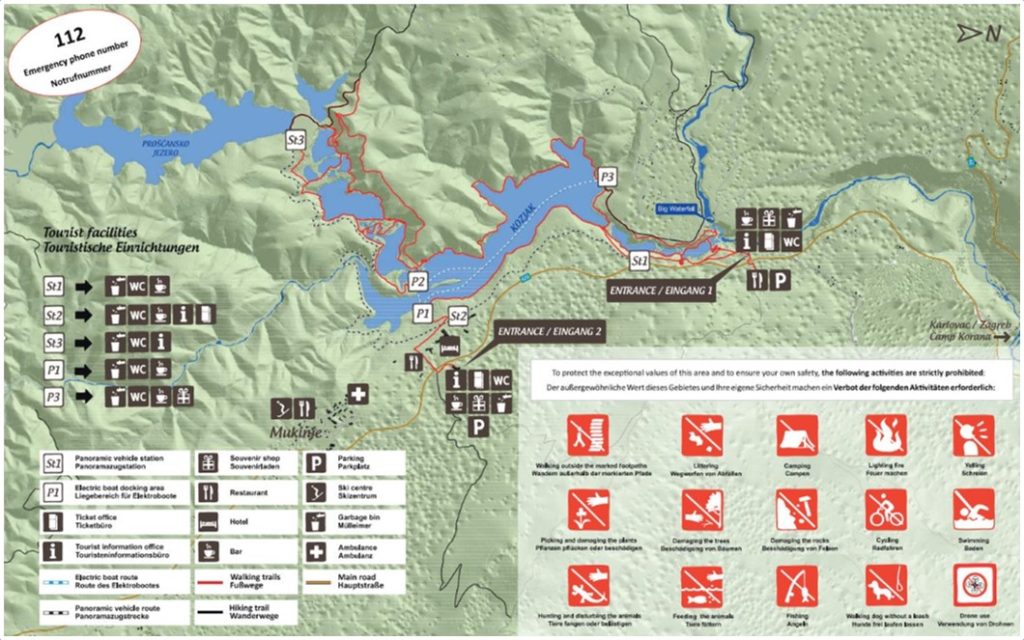
Plitvice Lakes National Park provides seven recommended routes exploring both the Upper and Lower Lakes. The park refers to these routes as “programs,” each with its own circuit identified by markers throughout the park. Each program has a corresponding letter and is color coded based on starting point. Visitors entering the park at Entrance 1 can choose between four routes, marked in green. The four routes beginning at Entrance 2 are marked in orange. Info panels at the park’s entrances also display the routes, and maps are available at info points.
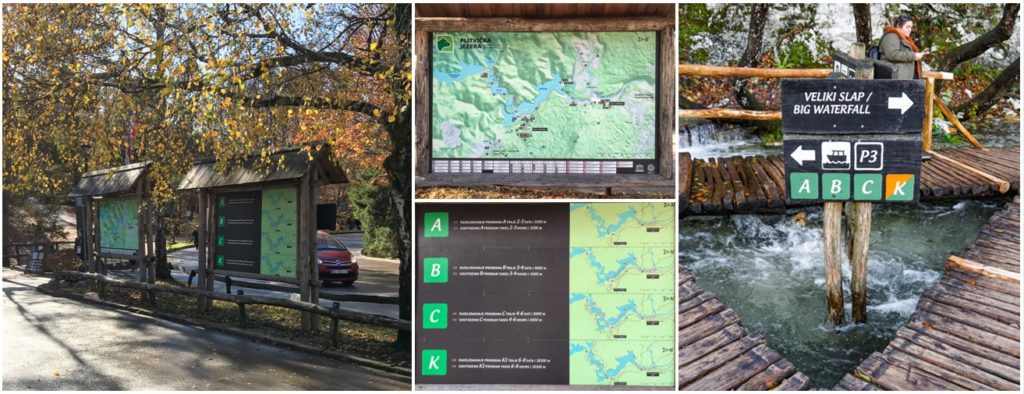
The routes vary in distance and therefore in the length of time needed to complete them. The shortest route takes roughly 2 hours and covers many of the park’s highlights. The longest route can take up to 8 hours and tours both the upper and lower lakes. All seven of the park’s programs can be found on their website.

For visitors with only one day at Plitvice Lakes National Park, we recommend “Program B” starting at Entrance 1. This route covers the Lower Lakes and provides a great overview of what the park has to offer. It will satisfy travelers who are looking to experience the park’s main attractions, see stunning scenery, take beautiful photos, and connect with nature. Many of Plitvice’s most recognizable vistas will be seen on this route. If staying a second day, we recommend following up with “Program E” to cover the Upper Lakes beginning at Entrance 2. The combination of those two programs will cover the entire lakes area of the park.
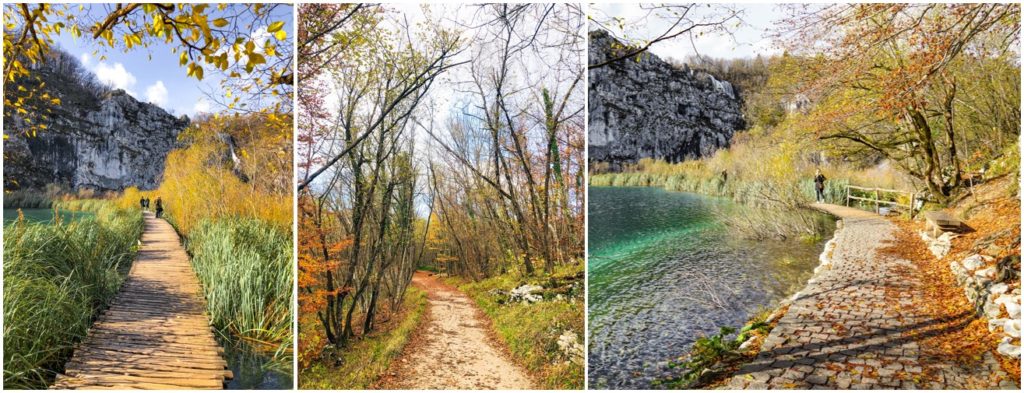
The walking trails in the park are well maintained and safe. The vast majority of the paths are flat, though in some areas you may find stairs or an incline. In general, however, the trails are not challenging and appropriate for a variety of ages and fitness levels. Wooden trails snake over the lakes while dirt paths or stone walkways connect other areas. Be sure to exercise caution when on uneven surfaces. Mist from the waterfalls can also cause some areas to be slippery.
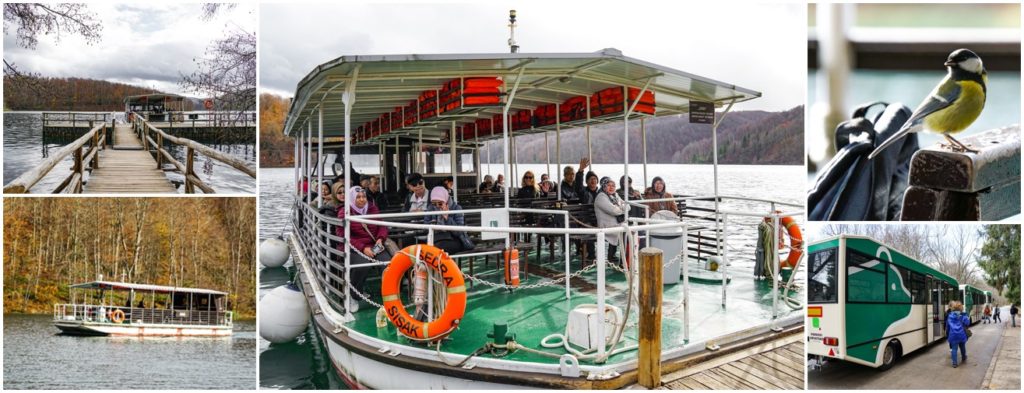
Some of the programs involve an electric boat or panoramic train ride in addition to the walking trails. These provide a relaxing and scenic way to cover more ground at the park. Your entrance ticket should be kept on you at all times and grants access to both the boat and train. Schedules vary with season, so be sure to check the timetable at one of the info points.

Plitvice Lakes National Park encompasses an area of just under 300 square kilometers with the lakes themselves comprising just 1% of this expanse. The remainder of the park is made up of a wooded forest of beech, fir and pine trees which is home to deer, bears, wolves, wildcats and rare bird species – a paradise for nature lovers and curious travelers alike.
In addition to the walking routes which circle the Lower and Upper Lakes, hiking trails provide the opportunity to explore the wooded areas and surrounding mountains. Beyond the park, this region is a wonderful place to enjoy activities such as river kayaking, cycling, horseback riding, ziplining, and more. Our Tasteful Croatian Journeys Concierge, Mirela, is happy to make these arrangements for our travelers. Roughly 30 minutes north of Plitvice Lakes National Park is the small town of Rastoke. Popular among tourists for its cascading waterfalls, this village provides a nice opportunity to stop and stretch one’s legs when making the drive to Plitvice Lakes National Park from Zagreb.

Tickets – Tickets to Plitvice Lakes National Park must be purchased a minimum of 2 days before entering the park. Tickets can be purchased for a single day, or multiple days, and must include an entrance time and gate for your first point of entry. There are two entrances to the park. If you choose to do a multi-day ticket, entrance on your first day must be at the time and entrance specified on the ticket. On all subsequent visits you may enter through any of the park’s entrances. You will be able to enter the park 30 minutes before, or up to 1 hour after the time specified on your ticket. Tickets can be purchased on the Plitvice Lakes National Park website.
Facilities – Info points, trail maps, luggage storage, ATMs, currency exchange, restrooms, souvenir shops, and restaurants can all be found at both Entrance 1 and Entrance 2 of the park. Several government run National Park hotels are also located at Entrance 2 of the park.
Within the park there are several restaurants and cafés serving simple fast food such as grilled meats, sandwiches, or pastries and hot or cold drinks. They are located at the P3 Electric Boat stop and the St1, St2 and St3 panoramic train stops. Restrooms can also be found at those locations. Just outside the park several restaurants with more expansive menus can be found. More on those and the hotels below.
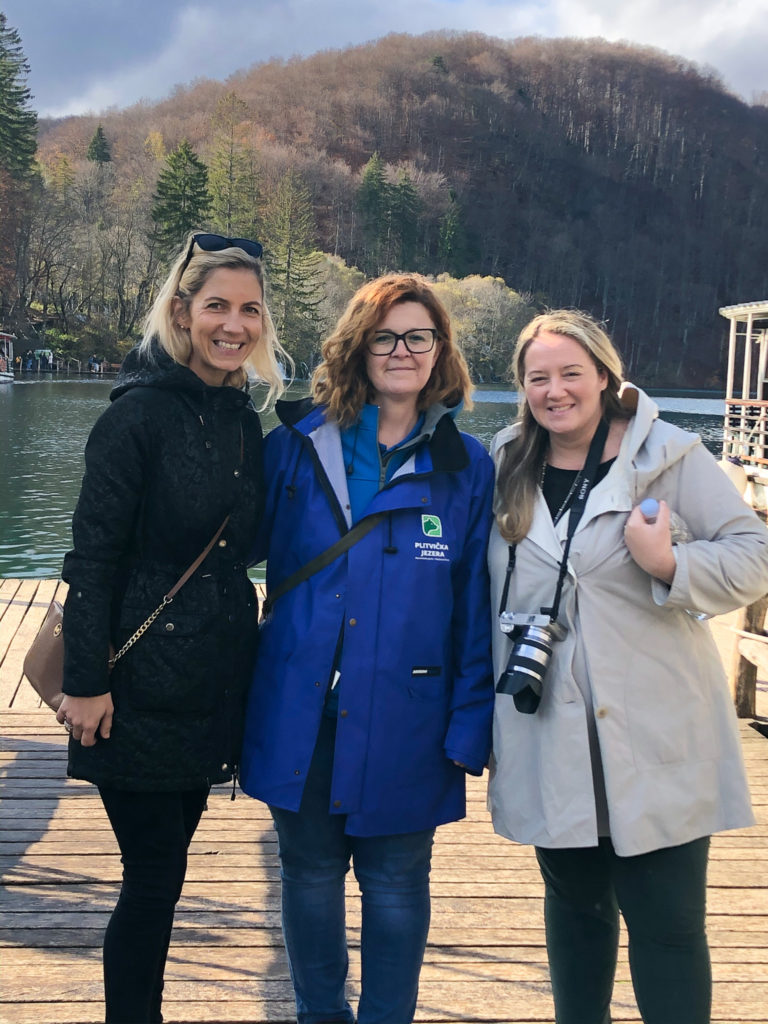
Guides – A guide is not required to tour Plitvice Lakes National Park and the well-marked routes make the park easy to navigate on one’s own. However, for those seeking deeper insight to the park’s ecology and history, we highly recommend a private guided tour. Not only will a local guide share their valuable knowledge about the national park, but also about the region, its culture, and its unique traditions.
What to Wear – When touring the park, it is important to wear the appropriate clothing and footwear. Sneakers, hiking boots, or comfortable walking shoes are recommended with a non-slip sole that is suitable for a variety of surfaces such as wood, stone and dirt. Do not wear flip-flops! Mist from the waterfalls or rain showers can also cause wet conditions for which a waterproof jacket is advisable. In the summer, lightweight clothing as well as a hat, sunglasses, and sunblock are recommended. In cooler temperatures, plan on long pants and heavier clothing. Be sure to bring a bottle of water as it is important to stay hydrated.
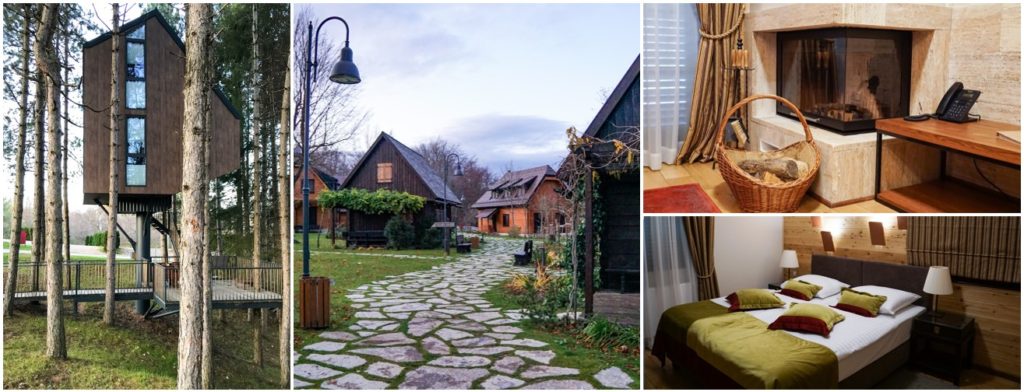
Where to Stay – There are a number of government run hotels located at Entrance 2 of the park. These include Hotel Jezero, Hotel Plitvice, and Hotel Bellevue. They all provide simple but clean and affordable accommodation with an ideal location exploring the lakes. For something more unique, consider one of the following.
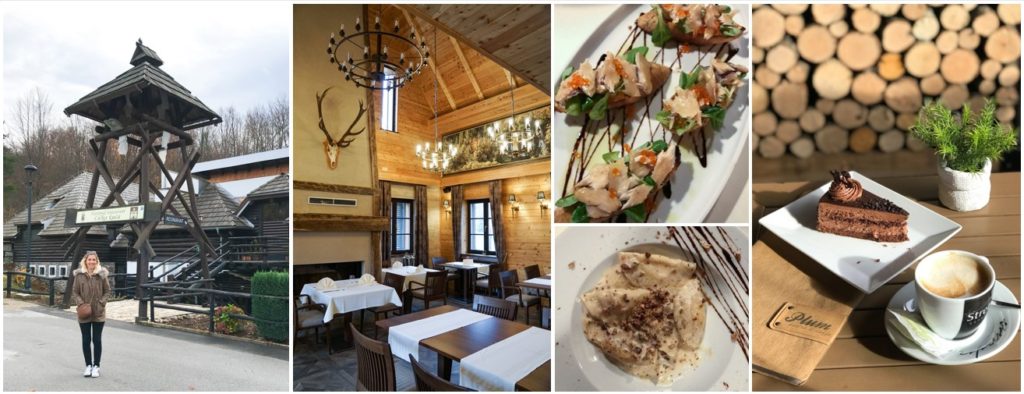
Where to Eat – The cuisine of Croatia’s rugged and mountainous interior reflects the rich variety of natural ingredients available to the region. Here you will find a great number of restaurants offering rural, traditional meals, which focus on wild game, freshwater fish, and an array of hearty vegetables. National Restaurant Lička Kuća, located just outside Entrance 1 of Plitvice Lakes National Park, is an homage to the region and its cuisine. The enormous restaurant is decorated in the traditional style with artifacts from the region on display for visitors. In the center of the restaurant, an open hearth displays lamb roasting on a spit and “peka” (a hearty meat and vegetable dish) cooking under an iron dome. The restaurant makes use of regional recipes and locally sourced products. Farther afield, Hotel Degenija has two restaurants which have become popular dining spots for both locals and in-the-know travelers alike. The first is the recently renovated Restaurant Degenija which is well known for its quality cuisine, ranging from traditional meat dishes to grilled local trout to freshly made pizzas. The second is Bistro & Caffe Plum, a stylish café which offers international cuisine and impressive cocktails in a modern space with an inviting terrace. Finally, if seeking something a bit upscale, try Restoran Kozjak at the Fenomen Plitvice Resort. The interior resembles a modern hunting lodge with rustic wood ceilings and antlers as décor. The menu features traditional meals with a sophisticated touch, such as smoked trout bruschetta or ravioli stuffed with honey and traditional basa cheese from the Lika region.

Opening times – Opening hours vary seasonally, and it is important to note that the certain trails and/or areas of the park are not open during the winter season. For more information about current conditions when you visit, please consult the Plitvice Lakes National Park website.
Location – Plitvice Lakes National Park is located in Croatia’s Adriatic hinterland, roughly 2 hours south of the capital city of Zagreb, and about 1.5 hours north of the historic port city of Zadar. It is an easy day trip from either location and also makes a wonderful overnight stop for travelers en route to Dalmatia from areas such as Istria or Zagreb. Tasteful Croatian Journeys can make arrangements for your visit via private transfer in a luxury vehicle with a professional, English-speaking local driver.

Note: Site inspections are an important element of our work. Before recommending a hotel, restaurant, activity or location to our travelers, we first personally explore, experience, test, taste, and finally, if worthy, approve the experience. Only then do we invite our travelers to join in the experience. Recently, our Luxury Travel Designer Tia Lovisa Moreira, and Tasteful Croatian Journeys Concierge, Mirela Benic, traveled through northern Croatia conducting site inspections. All photos used above were taken by Tia and Mirela on their recent trip in November 2019. To see more images of Plitvice Lakes National Park, we invite you to view the gallery of below which has been provided directly by the National Park.
 About the Author:
About the Author: